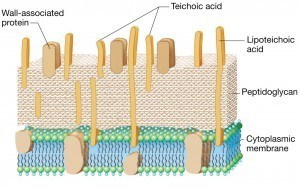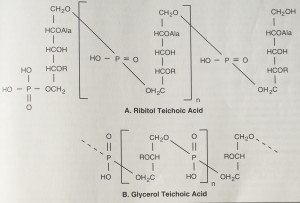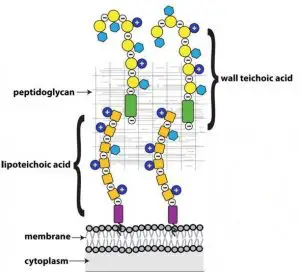 Teichoic acids were discovered in 1958 by Armstrong and co-authors.
Teichoic acids were discovered in 1958 by Armstrong and co-authors.
Gram Positive Cell wall with Teichoic acid
Substituent group on the polyol chains can include D-alanine (ester linked), N-acetylglucosamine, N-acetylgalactosamine, and glucose; the substituent is characteristic for the teichoic acid from a particular bacterial species and can act as a specific antigenic determinanat.
Teichoic acids are located in the outer layer of certain gram positve bacteria (such as Staphylococci, Streptococci, Lactobacilli and Bacillus spp). So far teichoic acids have not been found in Gram Negative Bacteria.
 Teichoic
acids include both lipoteichoic acids (LTAs), which are anchored in
the bacterial membrane via a glycolipid, and wall teichoic acids (WTAs),
which are covalently attached to peptidoglycan.
Teichoic
acids include both lipoteichoic acids (LTAs), which are anchored in
the bacterial membrane via a glycolipid, and wall teichoic acids (WTAs),
which are covalently attached to peptidoglycan.Lipoteichoic acid: Teichoic acid that covalently linked to the lipid in the cytoplasmic membrane. Some techoic acids anchor to the muramic acid in the peptidoglycan.
Medical Importance of Teichoic Acid:
- They induce septic shock through the same pathways as does endotoxin (Lipopolysaccharide ) in gram negative bacteria.
- Mediate the attachment of staphylococci to mucosal cells.
- Teichoic acids are highly negative charged polymers so they can serve as a cation-sequestering mechanism.



0 Comments:
Post a Comment